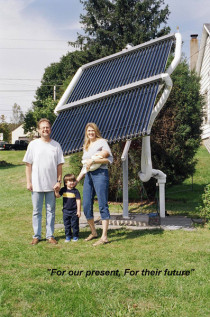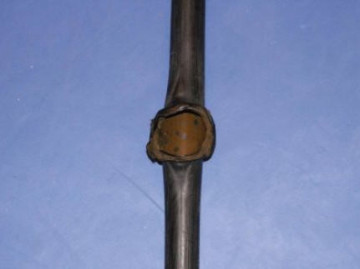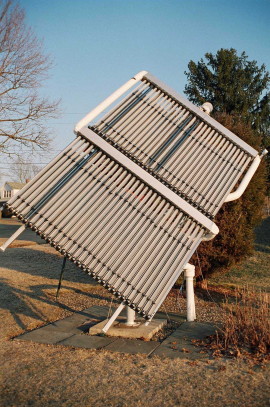Solar Energy Information
The above SFB-30's were setup to track the sun. This is not the normal way the collectors are mounted. The majority of the time the units are mounted to the roof of the structure, or as a free standing fixed array. Care must be taken with free standing arrays to make sure they are not subject to the structure's shadow's over the course of the day, and designed strong enough to handle the weight and wind loadings of the collectors. Ground supports should go down below the frost line, usually four to five feet depending on the climate. When a thermal solar array (Not PV) is more than about fifty feet from the storage tank or delivery point, piping losses can become significant. Great attention should be paid to the total heat loss per foot of the piping run, not just the R-value of the pipe insulation, which by itself, does NOT represent the total heat lost!!
General System Sizing guidelines.
For DHW, (Domestic Hot Water) :
One SFB-30 for one to three people, 50 to 80 gallons of storage. Two SFB-30's four to six people, 80 to 160 gallons of storage.
For single tank DHW "boost" system: (Backup tank is also solar tank)
One SFB-20 or one SFB-30, existing single tank 40 to 80 gallons of storage.
Space heating arrays in the Northeast:
Usually, 6 or more SFB-30's are required to make any kind of "real" dent in space heating loads for a typical square footage house (2000-3000 sqft). Many factors go into planning the "right" total system for any given house because there is so much variability in home construction.
Ten "Key" points in designing any solar thermal (Heat) system.
Mounting angle should be determined by the latitude and solar application. For DHW (Domestic Hot Water) only, the angle the back edge of the collector is raised up from the horizontal, should equal the latitude. For space heating, 20 Degs minimum more than latitude, all the way to vertical (Snow regions) works well. For Summer pool heating, 20 Degs minimum under latitude works fine.
Units should face true south if possible. Up to 20 Degs East or West of South will not have a significant impact.
Care should be taken in choosing the collector location. The location should receive as much sun as possible and be free from shadowing from All sources. They should be as close as possible to the thermal storage tank(s) if used, to keep the piping runs to and from as short as possible. This is very important especially if a non drain-back system is employed. If the system is to be expanded later, make sure you allow room for the additional collectors.
Drain back "styles" of systems should be used whenever possible. Allot of heat is used, heating up the anti-freeze in a closed loop system at the start of each day. Additionally, that heat is "left behind" at the end of the day unable to be utilized. It does add up to significant amounts. The longer the run the greater the accumulated losses.
Insulation values of R20 or greater should be used on piping runs. Solar energy is a low temperature large area heat source which is not on demand. This makes solar thermal installations very sensitive to piping run losses. The longer the run the greater the loss. R value by itself does not represent the total heat loss for the piping run, but is offered as a very general guide point. Care should be taken to reduce run losses to an absolute minimum, so the solar investment is not wasted. The importance of High R-value per inch insulation can not be over stated.
The system should be designed "in balance" with itself along with the application and "life style" of the user. What this refers to is the main parts of the system, collectors, infrastructure and storage, should be sized for each other, and then as a whole, sized for the application. The users "life style" can effect over all design aspects as well, from sizing to control specifics.
For all but low temperature applications, copper pipe should be used throughout the entire infrastructure. This is particularly important with evacuated tube collectors due to their higher temperature capability. There are few exceptions to this. Plastic pipe can maintain integrity under normal system circumstances, but under stagnation conditions, excessive temperatures can cause the plastic to soften and blow out even under closed loop low system pressures as shown below.
Care should be taken on choosing insulation that will handle the maximum temperatures at various places in the system. Again, insulation on or near evacuated tube collectors should handle stagnation temperatures, often greater than 300 DegF.
A backup power scheme should be included with the system. There is no reason to allow the system to be subjected to freezing temperatures if potentially harmful, or stagnation temperatures either, in sunny power fail situations.
If saving re-occurring energy expenses is the reason you are doing solar, then keep in mind the more you spend up front for your products, the longer the
return on the investment. Good products are available for very reasonable prices, without spending thousands of dollars extra for a couple of percent more in extra efficiency, of which
the investment return you will never see over the life of the system.
You can do "Green" without putting yourself in the "Red".
Carbon VS Alkaline??? An Analogy....
Just like the old battery commercials comparing Carbon to Alkaline, the comparisons between flat plates and evacuated tube collectors are much the same. In reality though, Alkaline's are a far superior technology, so comparing them to Carbon was sort of like comparing a 1930's Indy car to a 2000 Indy car. There just isn't a comparison. The photo below was taken on March 23, 2005, at 7:15AM in the morning, after a fairly heavy frost. Four of the sixty evacuated tubes had their vacuum's deliberately compromised. Anotherwards, they have air, just like a flat plate collector between the absorber and the outer glass glazing, no vacuum! Can you spot the four tubes that have had the ice melted off by the escaping collected solar heat? .....Comparison ended......
Real data for above array!!!!!
01/18/2005 Overnight low 7 DegF
Average outside daytime temperature 10 DegF
Available direct solar radiation 40 Deg Latitude, per square foot all day total 2182 BTU's * 60 sqft = 130,920 BTU's gross energy
Storage starting temperature 68 DegF
Storage ending temperature 94 DegF
Storage temperature gain 26 DegF = 78,000 BTU's (3000 pound water storage unit)
BTU usage during solar gain period 4,000 BTU's
Total net solar gain 82,000 BTU's (78,000 + 4,000)
efficiency = 63 % ( 82,000 /130,920)
01/21/2005 Overnight low 2 DegF
Average outside daytime temperature 8 DegF
Available direct solar radiation 40 Deg Latitude, per square foot all day total 2182 BTU's * 60 sqft = 130,920 BTU's gross energy
Storage starting temperature 68 DegF
Storage ending temperature 97 DegF
Storage temperature gain 29 DegF = 87,000 BTU's (3000 pound water storage unit)
BTU usage during solar gain period 3,000 BTU's
Total net solar gain 90,000 BTU's (87,000 + 3,000)
efficiency = 69 % ( 90,000 /130,920)
01/27/2005 Overnight low -2 DegF
Average outside daytime temperature 13 DegF
Available direct solar radiation 40 Deg Latitude, per square foot all day total 2282 BTU's * 60 sqft = 136,920 BTU's gross energy
Storage starting temperature 65 DegF
Storage ending temperature 95 DegF
Storage temperature gain 30 DegF = 90,000 BTU's (3000 pound water storage unit)
BTU usage during solar gain period 3,000 BTU's
Total net solar gain 93,000 BTU's (90,000 + 3,000)
efficiency = 68 % ( 93,000 /136,920)
01/28/2005 Overnight low -12 DegF
Average outside daytime temperature 14 DegF
Available direct solar radiation 40 Deg Latitude, per square foot all day total 2282 BTU's * 60 sqft = 136,920 BTU's gross energy
Storage starting temperature 82 DegF
Storage ending temperature 105 DegF
Storage temperature gain 23 DegF = 69,000 BTU's (3000 pound water storage unit)
BTU usage during solar gain period 6,000 BTU's
Total net solar gain 75,000 BTU's (69,000 + 6,000)
efficiency = 55 % ( 75,000 /136,920)
01/31/2005 Overnight low 12 DegF
Average outside daytime temperature 32 DegF
Available direct solar radiation 40 Deg Latitude, per square foot all day total 2332 BTU's * 60 sqft = 139,920 BTU's gross energy
Storage starting temperature 81 DegF
Storage ending temperature 104 DegF
Storage temperature gain 23 DegF = 69,000 BTU's (3000 pound water storage unit)
BTU usage during solar gain period 6,000 BTU's
Total net solar gain 75,000 BTU's (69,000 + 6,000)
efficiency = 54 % ( 75,000 /139,920)
02/01/2005 Overnight low 0 DegF
Average outside daytime temperature 32 DegF
Available direct solar radiation 40 Deg Latitude, per square foot all day total 2332 BTU's * 60 sqft = 139,920 BTU's gross energy
Storage starting temperature 94 DegF
Storage ending temperature 114 DegF
Storage temperature gain 20 DegF = 60,000 BTU's (3000 pound water storage unit)
BTU usage during solar gain period 9,000 BTU's
Total net solar gain 69,000 BTU's (60,000 + 9,000)
efficiency = 49 % ( 69,000 /139,920)
02/02/2005 Overnight low 0 DegF
Average outside daytime temperature 35 DegF
Available direct solar radiation 40 Deg Latitude, per square foot all day total 2332 BTU's * 60 sqft = 139,920 BTU's gross energy
Storage starting temperature 102 DegF
Storage ending temperature 120 DegF
Storage temperature gain 18 DegF = 54,000 BTU's (3000 pound water storage unit)
BTU usage during solar gain period 10,000 BTU's
Total net solar gain 64,000 BTU's (54,000 + 10,000)
efficiency = 48 % ( 64,000 /139,920)
03/15/2005 Overnight low 17 DegF
Average outside daytime temperature 35 DegF
Available direct solar radiation 40 Deg Latitude, per square foot all day total 2916 BTU's * 60 sqft = 174,960 BTU's gross energy
Storage starting temperature 102 DegF
Storage ending temperature 122 DegF
Storage temperature gain 20 DegF = 60,000 BTU's (3000 pound water storage unit)
BTU usage during solar gain period 4,000 BTU's
Total net solar gain 64,000 BTU's (60,000 + 4,000)
efficiency = 37 % ( 64,000 /174,960)
System detail of 03/15/2005:
The following chart shows collector, storage and return temps hourly throughout the day: Lessons to be learned, you cannot over insulate piping runs!! All temps DegF.
Note also the difference in storage gain between sunrise and 9:00am VS 3:00pm and sunset. System is anti-freeze closed loop.
Time of Day Return Collector Storage
Outside
Sunrise n/a
20 102 16
8:00am 108
112 103 20
9:00am 113
118 104 23
10:00am 117
122 107 26
11:00am 119
124 109 30
12noon 122
126 111 34
1:00pm 124
129 114 35
2:00pm 126
131 116 37
3:00pm 127
132 118 40
4:00pm 127
132 120 42
5:00pm 123
127 122 40
EOD cycling at 5:15pm
At these temperatures, 1/3 or more of the energy is lost in the piping run of this system!! Total run ~140'.
03/27/2006 Overnight low 32 DegF
Average outside daytime temperature 48 DegF
Available direct solar radiation 40 Deg Latitude, per square foot all day total 2916 BTU's * 60 sqft = 174,960 BTU's gross energy
Storage starting temperature 72 DegF
Storage ending temperature 106 DegF
Storage temperature gain 34 DegF = 102,000 BTU's (3000 pound water storage unit)
BTU usage during solar gain period 3,000 BTU's
Total net solar gain 105,000 BTU's (102,000 + 3,000)
efficiency = 60 % ( 105,000 /174,960)
Analysis of 01/21 & 01/27: They were absolutely perfectly cloudless days, very, very clear, low water vapor, plus we had some more snow on the ground adding solar
ground reflection gain. Big factor, a cool storage reducing piping run loss.
Note: All PSD's are not created equal.
Rule Of Thumb: AS a general "feel" for the collectors on a full overcast day, it goes about like this: On a very dark overcast day, the collectors will reach under a no flow condition about 30 DegF above ambient. On a average brightness fully overcast day, they will reach under a no flow condition about 50 to 60 DegF above ambient, and on a bright fully overcast day (Still not able to see ring of sun) they will reach under a no flow condition about 80 to 100 DegF above ambient.



